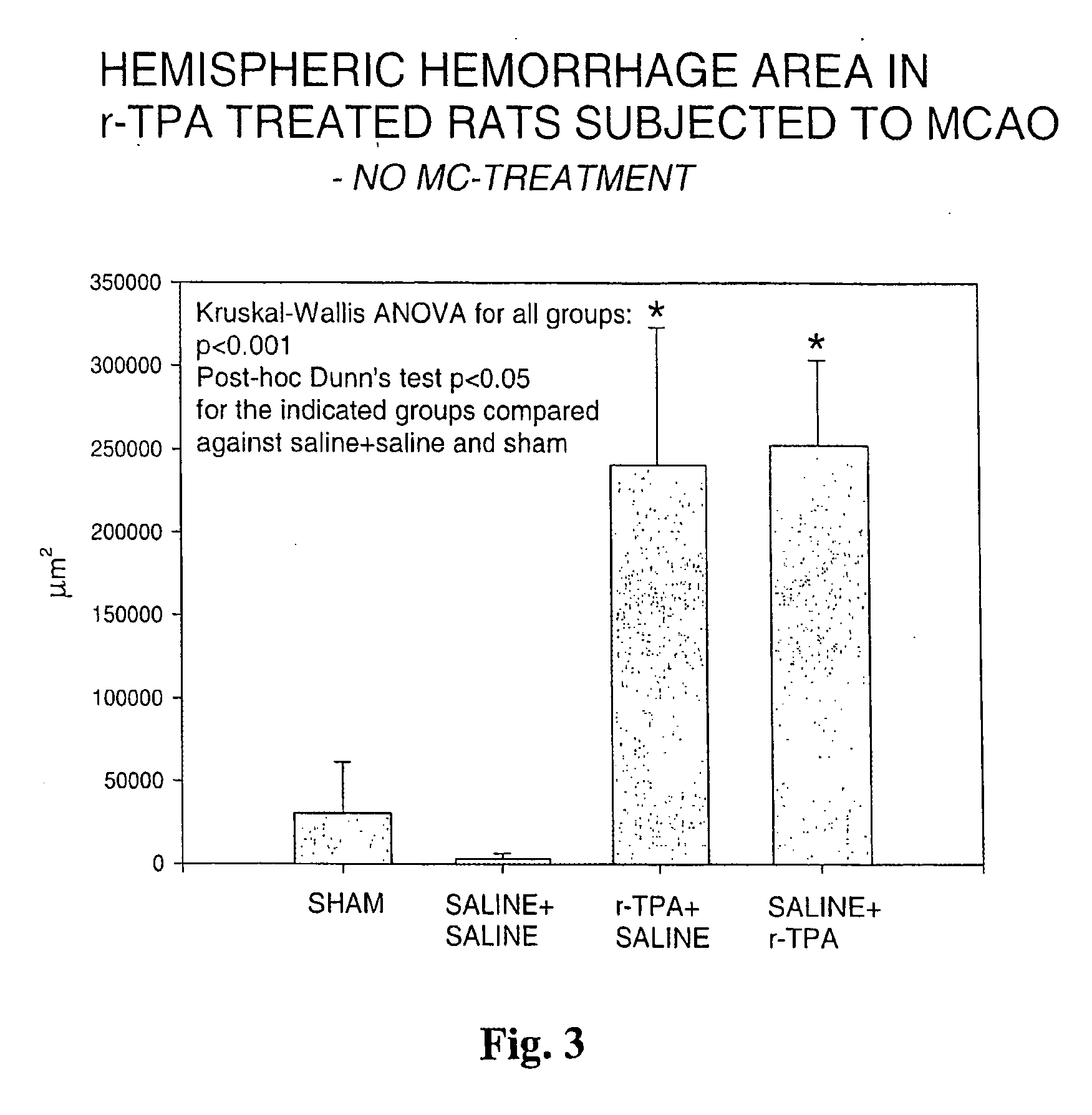Use of a mast cell activation or degranulation blocking agent in the manufacture of a medicament for the treatment of a patient subjected to thrombolyses
a technology of activation or blocking agent and mast cell, which is applied in the direction of plant growth regulators, biocide, animal husbandry, etc., can solve the problems of ischemic edema, the most dreaded and deadly brain reaction, and the basis of any therapeutic method or surgical procedure modification, etc., to reduce the severity of hemorrhagic and reduce the risk of death
- Summary
- Abstract
- Description
- Claims
- Application Information
AI Technical Summary
Benefits of technology
Problems solved by technology
Method used
Image
Examples
example 1
Methods:
[0057] The suture filament model was used to induce focal cerebral ischemia for 60 min in rats. Reperfusion was allowed for 3 h, at which point the rats were killed, cardioperfused and their brains were dissected into coronal sections. Evans Blue-albumin (2%, 0.3 ml / 100 g) a fluorescent dye, was injected i.v. 20 min before termination to monitor BBB (blood brain barrier) permeability. TTC (2,3,5-triphenyltetrazolium chloride, 2%) staining was used to quantitate the infarct volumes. The volumetric expansion of the ischemic hemisphere was quantitated with computerized planimetry. Rats were assigned in three pharmacological treatments: mast cell stabilizer disodium cromoglycate 750 ug in 10 ul i.c.v. (does not easily cross BBB) (n=14) or control (10 ul saline i.c.v.) (n=13) 5 min prior to ischemia, and a mast cell degranulation agent, compound 48 / 80 (n=11) administered (0.025 mg i.v.) 3 min prior to reperfusion. The Evans Blue extravasation was analysed using fluorescence mic...
example 2
[0060] Rats were given 10 mg / kg of r-TPA, which is considered equivalent to the typical dose given to humans in thrombolysis in stroke and myocardial infarction. Two timings of r-TPA were used to investigate in rat brain the hemorrhagic conversion of infarction, the single most serious complication and hazard in clinical thrombolytic therapy. The group termed r-TPA+saline received 1-hour infusiuon of r-TPA starting 5 minutes (10% as bolus) prior to reperfusion after 90 min of middle cerebral artery occlusion (MCAO), whereas the group saline+r-TPA received r-TPA starting 1 hour after the reperfusion after 90 min of MCAO. Both timings resulted in significant hemorrhage formation, as compared to sham operated or saline-treated controls. Brains were dissected at 4.5 hours after reperfusion. Areas of hemorrhage were measured by microscopical image analysis on six histological sections cut through the hemispheres and added together (cf. FIG. 3)
[0061] The polymorphonuclear leukocytes (neu...
example 3
[0064] Additional data was derived from experiments using mast cell-deficient WsRcWs / Ws rats carrying a defective gene for c-kit (ligand for stem cell factor [SCF]) required for mast cell differentiation) and their wild-type littermates. Animals were subjected to transient focal cerebral ischemia and treated with r-TPA as described above. In the mast cell deficient rats, the mean area of hemorrhage measured on the midline histological brain section was 142625:m2 and 7100:m2 in the wild-type littermates (p<0.01).
[0065]FIG. 6 shows the results obtained for MC-deficient gene manipulated rats and their non-manipulated littermates subjected to 90 min of MCAO and 4.5 hours of reperfusion. The density of neutrophils were counted in the tissue section encompassing basal ganglia, the infarct core and penumbra. The number of neutrophils was significantly reduced in the MC-deficient rats, especially in the infarct core and basal ganglia. In the lower panel it is indicated that the reduction i...
PUM
| Property | Measurement | Unit |
|---|---|---|
| volumes | aaaaa | aaaaa |
| area | aaaaa | aaaaa |
| area | aaaaa | aaaaa |
Abstract
Description
Claims
Application Information
 Login to View More
Login to View More - R&D
- Intellectual Property
- Life Sciences
- Materials
- Tech Scout
- Unparalleled Data Quality
- Higher Quality Content
- 60% Fewer Hallucinations
Browse by: Latest US Patents, China's latest patents, Technical Efficacy Thesaurus, Application Domain, Technology Topic, Popular Technical Reports.
© 2025 PatSnap. All rights reserved.Legal|Privacy policy|Modern Slavery Act Transparency Statement|Sitemap|About US| Contact US: help@patsnap.com



